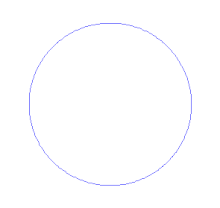The particle on the ring is one of the various model systems from quantum mechanics , which leads to the quantization of energy . It is very similar to the particle in the box and is therefore also referred to as the “particle in the circular potential box”.
In contrast to the particle in the box , however, the particle on the ring does not move linearly, but in a circular, potential- free manner around a certain point. Therefore it is better to calculate with polar than with Cartesian coordinates : the wave function of the particle does not depend on the general distance to the center (because it moves on a constant radius ), but only on the polar angle .



Mathematical consideration
To find the wave functions and the energies of the states of the particle on the ring, it is necessary to solve the stationary Schrödinger equation in the given potential. This is given by

The Hamilton operator can be written in polar coordinates for the relevant area as

which results in the Schrödinger equation to be solved:

It is therefore an ordinary, linear, homogeneous differential equation of the 2nd order, for which the solution is:

Substituting it into the Schrödinger equation gives

Reshaping gives the energies of the particle on the ring:

The fact that it must be an integer results from the boundary condition that the wave function must be the same again after one revolution on the ring:


which leads to the following condition:

This is only true for an integer.

In order to solve the differential equation uniquely ( ), the wave function still has to be normalized . This is done by integrating over their square of the amount using the above. Boundary condition from to :





To write to the wave function using the Euler's identity into

Since the magnitude of a complex number is defined as , one obtains




So the wave function for a particle on the ring is:

Since linear combinations of eigenfunctions for the same energy eigenvalue (i.e. here: with the same value for ) are also eigenfunctions for this eigenvalue, it follows (with Euler's identity) that one alternatively




as degenerate eigenfunctions to the eigenvalue . The changed factor results from the normalization of the wave functions.


degeneration
In addition to quantization, this relatively easy-to-calculate example leads to the concept of degeneracy . Since states that only differ in sign represent different states, but because of the same energies, there are two states with the same energy: the states are degenerate twice.


Solution space and Fourier series
An operator equation such as the Schrödinger equation requires certain properties for its solution (e.g. continuity, differentiability, periodicity). This limits the space of possible solutions (here wave functions). In the above illustration, for example.
Assuming that with the wave function can be written using the Fourier series



Where are the Fourier coefficients


Then the Schrödinger equation can be rewritten as an equation for the Fourier coefficients

This is simplified to by the uniqueness of the Fourier coefficients

The solution then has the form

See also
literature







































